Billbergia
Billbergia is a genus of flowering plants in the family Bromeliaceae, subfamily Bromelioideae.
| Billbergia | |
|---|---|
 | |
| Scientific classification | |
| Kingdom: | Plantae |
| Clade: | Tracheophytes |
| Clade: | Angiosperms |
| Clade: | Monocots |
| Clade: | Commelinids |
| Order: | Poales |
| Family: | Bromeliaceae |
| Subfamily: | Bromelioideae |
| Genus: | Billbergia Thunb. |
| Type species | |
| Billbergia amoena | |
| Synonyms[1] | |
| |
Description
The Billbergia species are rosette-forming, evergreen perennials, usually epiphytic, occasionally terrestrial or lithotypic in habit.[2] They are mostly medium-sized species with small funnel diameters. Most species are epiphytes, some species grow on plants, on rocks, as well as directly on the ground. Water collects in the leaf funnels. In many funnels there are small biotopes with several species of animals and algae and aquatic plants. The rough leaves are always reinforced on the edge (as with all genera of the Bromelioideae), with a spiked tip. In some species and varieties, the leaves are beautifully colored. In many species, suction scales are everywhere on the leaves, often also on the inflorescence.[3]
They often bloom with brilliantly colored flowers with long-lasting inflorescence (inflorescences). The inflorescence often hang with terminal scape, erect or decurved. Strikingly colored bracts (bracts) often sit on the inflorescence; the color red dominates (usually with a blue component).
Flowers bisexual, sessile or conspicuously pedicellate; sepals free; petals free, threefold with a double perianth, with basal appendages, often spirally recurved at anthesis; stamens free or adnate to the petals, the anthers without appendages; inferior ovary. There are three sepals present. The three petals often have different shades of blue, there are also yellow, green and white. Birds are the pollinators of the blue-flowered species. An important characteristic that distinguishes them from other genera is that their petals curl up when they wither. The individual flowers only bloom for a few hours and can be pollinated for much less time. Most species have small scales (Ligulea) at the base of the petals. The six stamens and the style often protrude far from the flower. The ovary are under constant. A large part of the species blooms at night. The flower formula is: bis
The fruits are multi-seeded berries are often heavily colored when ripe; red to blue dominate here. The fruits are eaten by animals (mainly by birds, less often by bats and monkeys). The seeds are excreted undigested and end up on branches with the feces.
Taxonomy
The Swedish botanist Carl Peter Thunberg (1743–1828) established the genus Billbergia in Plantarum Brasiliensium ..., 3, 1821 p. 30 with the type species being Billbergia speciosa.[4] The genus, named for the Swedish botanist, zoologist, and anatomist Gustaf Johan Billberg (1772–1844), is divided into two subgenera: Billbergia and Helicodea. Species in subgenus Helicodea are distinguishable by the tightly recurved 'clock spring' flower petals, unlike other billbergias where the petals are flared.
Species
| Subgenus | Image | Scientific name | Distribution |
|---|---|---|---|
| Subgenus Helicodea (Lemaire) Baker | Billbergia acreana H. Luther | Brazil (Acre) | |
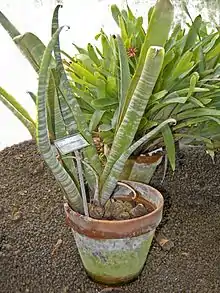 | Billbergia alfonsi-joannis Reitz | from Espírito Santo to Santa Catarina | |
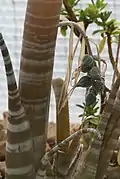 | Billbergia brasiliensis L.B.Sm. | Rio de Janeiro | |
| Billbergia brachysiphon L.B.Sm. | Brazil, Colombia, Ecuador | ||
| Billbergia cardenasii L.B.Sm. | Bolivia | ||
| Billbergia cylindrostachya Mez | Rio de Janeiro | ||
| Billbergia dasilvae Leme | Rondônia | ||
| Billbergia decora Poepp. & Endl. | Peru, Bolivia, Brazil | ||
 | Billbergia eloiseae L.B.Sm. & Read | Colombia | |
| Billbergia formosa Ule | Peru | ||
| Billbergia incarnata (Ruiz & Pavón) Schultes f. | Peru | ||
| Billbergia issingiana T.Krömer & E.Gross | Bolivia | ||
| Billbergia jandebrabanderi R.Vásquez & Ibisch | Bolivia | ||
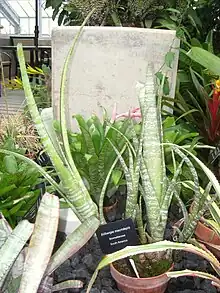 | Billbergia macrolepis L.B.Sm. | Costa Rica, Panama, Colombia, Ecuador, Venezuela, Guyana | |
| Billbergia magnifica Mez | Brazil, Paraguay | ||
| Billbergia meyeri Mez | Brazil, Bolivia | ||
| Billbergia microlepis L.B.Sm. | Bolivia | ||
| Billbergia oxysepala Mez | Acre, Ecuador | ||
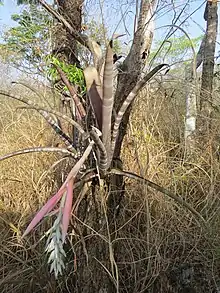 | Billbergia pallidiflora Liebmann | Mexico and Central America from Sinaloa to Nicaragua | |
 | Billbergia porteana Brongn. ex Beer | Brazil, Paraguay | |
| Billbergia robert-readii E.Gross & Rauh | Peru | ||
| Billbergia rosea Beer | Trinidad, Venezuela | ||
| Billbergia rubicunda Mez | Suriname | ||
| Billbergia rupestris L.B.Sm. | Colombia, Acre | ||
| Billbergia stenopetala Harms | Ecuador, Peru | ||
| Billbergia tessmannii Harms | Peru | ||
| Billbergia violacea Beer | Brazil, Colombia, Guianas | ||
| Billbergia zebrina (Herb.) Lindl. | Brazil, Argentina, Uruguay, Paraguay | ||
| Subgenus Billbergia | Billbergia ambigua (L.B.Sm. & Read) Betancur & N.R.Salinas, syn. Pseudaechmea ambigua | Antioquia | |
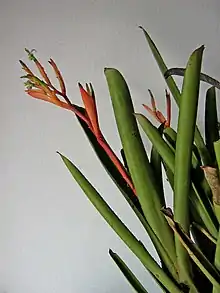 | Billbergia amoena (G.Lodd.) Lindl. | Brazil | |
| Billbergia bradeana L.B.Sm. | Espírito Santo | ||
 | Billbergia buchholtzii Mez | Brazil, but probably extinct | |
| Billbergia castelensis E.Pereira | Espírito Santo | ||
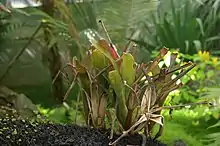 | Billbergia chlorantha L.B.Sm. | Espírito Santo | |
| Billbergia × claudioi Leme - Brazil | |||
 | Billbergia distachya (Vell.) Mez | southern Brazil | |
| Billbergia domingosmartinsis E.Gross | Espírito Santo | ||
| Billbergia elegans Martius ex Schultes f. | Espírito Santo, Minas Gerais | ||
.jpg.webp) | Billbergia euphemiae E.Morren | southeastern Brazil | |
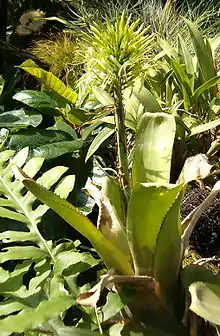 | Billbergia horrida Regel | southeastern Brazil | |
| Billbergia iridifolia (Nees & Mart.) Lindl. | southeastern Brazil | ||
| Billbergia kautskyana E.Pereira | Espírito Santo | ||
| Billbergia laxiflora L.B.Sm. | Espírito Santo | ||
 | Billbergia leptopoda L.B.Sm. | Bahia, Espírito Santo, Minas Gerais | |
| Billbergia lietzei E.Morren | Espírito Santo | ||
| Billbergia lymanii E.Pereira & Leme | southeastern Brazil | ||
| Billbergia macracantha E.Pereira | Rio de Janeiro | ||
 | Billbergia macrocalyx Hooker | Bahia, Minas Gerais | |
| Billbergia manarae Steyerm. | Venezuela | ||
| Billbergia minarum L.B.Sm. | Espírito Santo, Minas Gerais | ||
| Billbergia morelii Brongn. | eastern Brazil | ||
| Billbergia nana E.Pereira | Bahia, Espírito Santo | ||
 | Billbergia nutans H.Wendland ex Regel | Brazil, Argentina, Uruguay, Paraguay | |
| Billbergia pohliana Mez | Minas Gerais | ||
 | Billbergia pyramidalis (Sims) Lindl. | Brazil, Venezuela, French Guiana, Lesser Antilles, Cuba; naturalized in Mauritius | |
| Billbergia reichardtii Wawra | Espírito Santo, Minas Gerais | ||
| Billbergia sanderiana E.Morren | southeastern Brazil | ||
| Billbergia saundersii W.Bull | eastern Brazil | ||
| Billbergia seidelii L.B.Sm. & Reitz | Espírito Santo, Rio de Janeiro | ||
| Billbergia speciosa Thunb. | southeastern Brazil | ||
| Billbergia tweedieana Baker | southeastern Brazil | ||
| Billbergia viridiflora H.Wendland | Belize, Guatemala, Tabasco | ||
 | Billbergia vittata Brongn. | eastern Brazil | |
Distribution
They are native to forest and scrub, up to an altitude of 1,700 m (5,577 ft), in southern Mexico, the West Indies, Central America and South America, with many species endemic to Brazil.[1]
References
- Kew World Checklist of Selected Plant Families
- RHS A-Z encyclopedia of garden plants. United Kingdom: Dorling Kindersley. 2008. p. 1136. ISBN 978-1405332965.
- "Name - !Billbergia Thunb". Tropicos. 2022-04-09. Retrieved 2022-04-10.
- "Encyclopaedia of Bromeliads". Bromelia Contact Groep. Retrieved 2022-04-10.
External links
 Media related to Billbergia at Wikimedia Commons
Media related to Billbergia at Wikimedia Commons Data related to Billbergia at Wikispecies
Data related to Billbergia at Wikispecies
This article incorporates text from a publication now in the public domain: Chisholm, Hugh, ed. (1911). "Bromeliaceae". Encyclopædia Britannica. Vol. 4 (11th ed.). Cambridge University Press. p. 632.